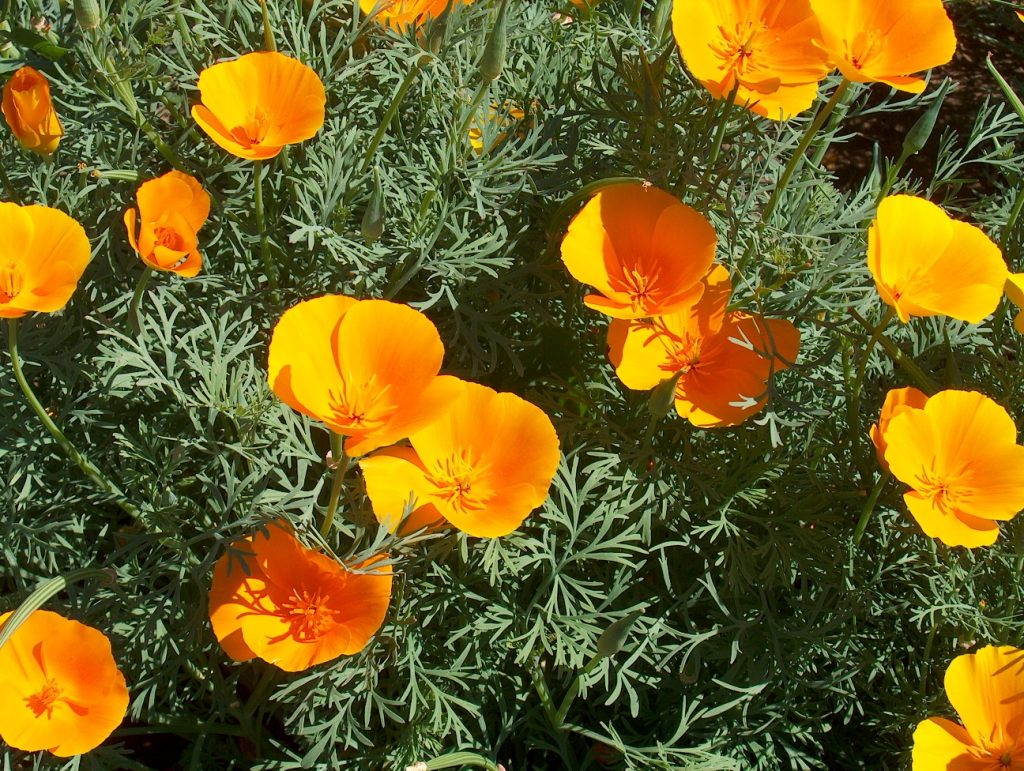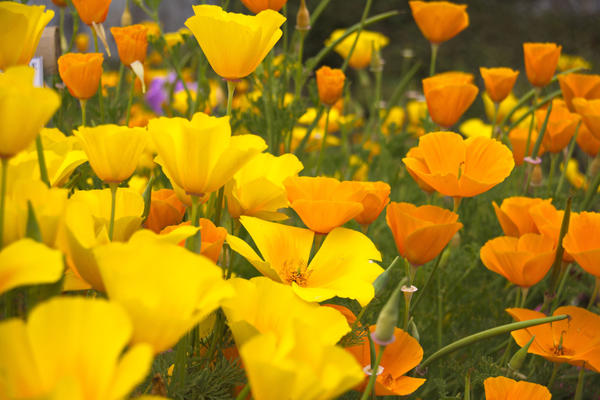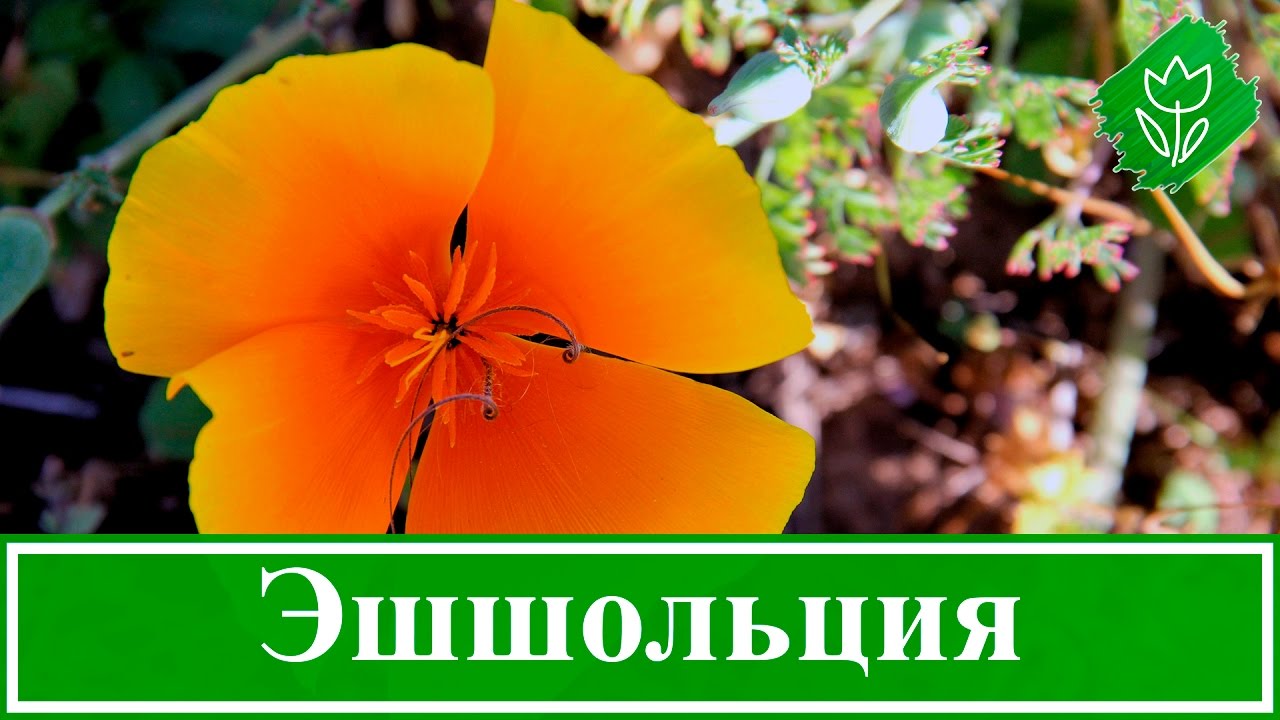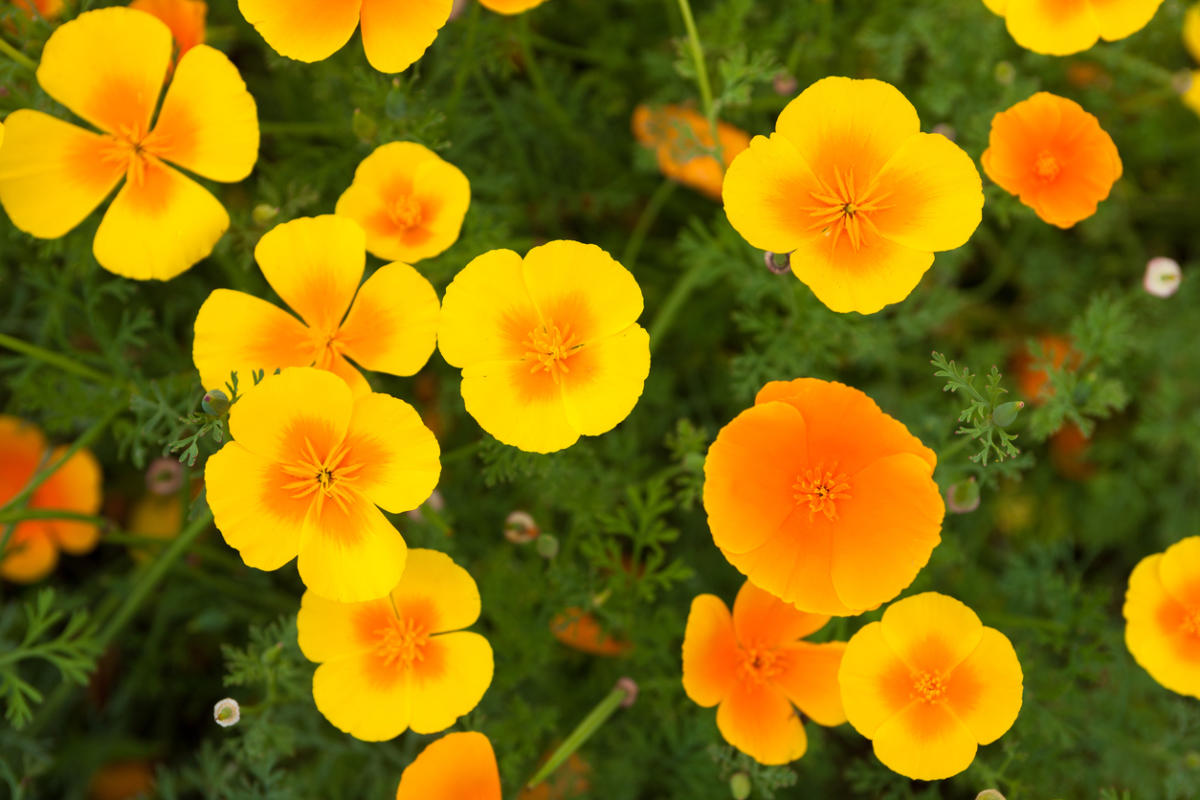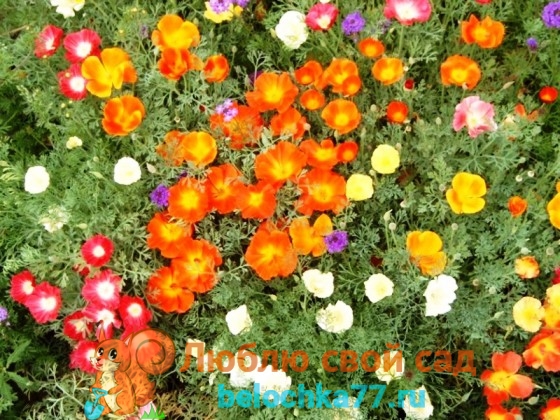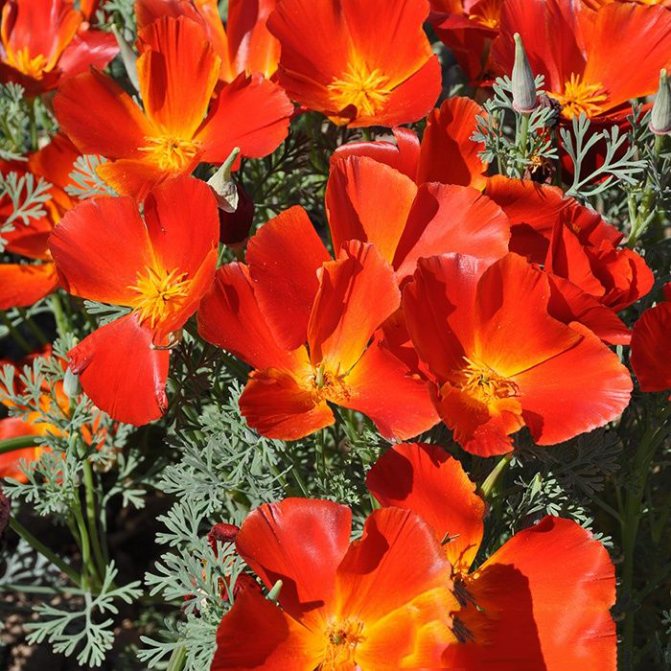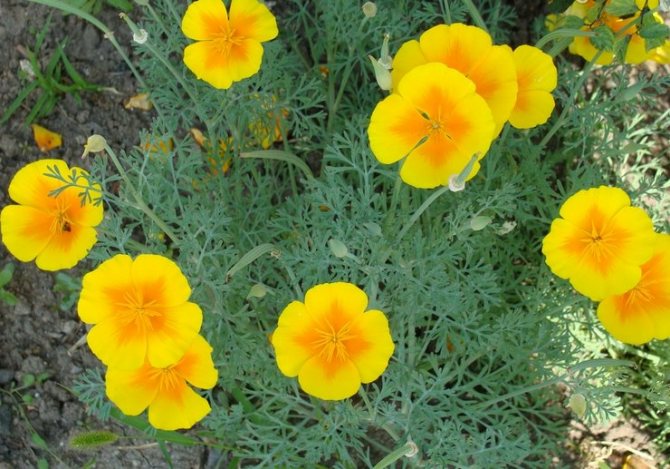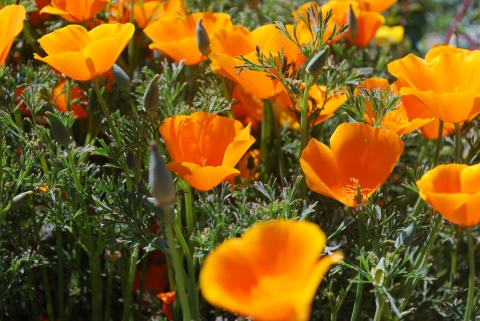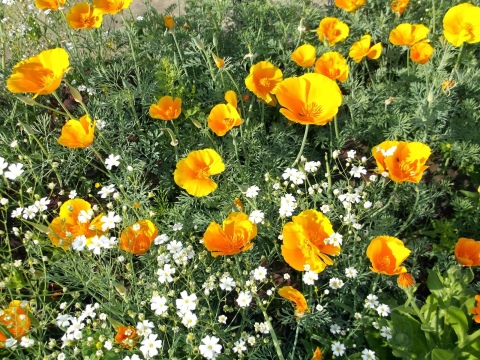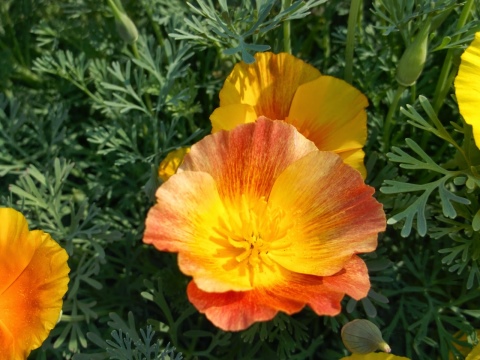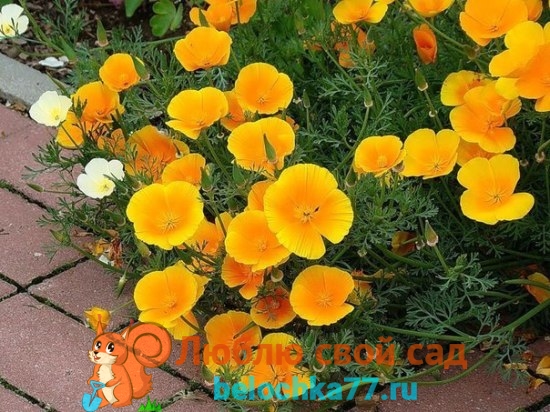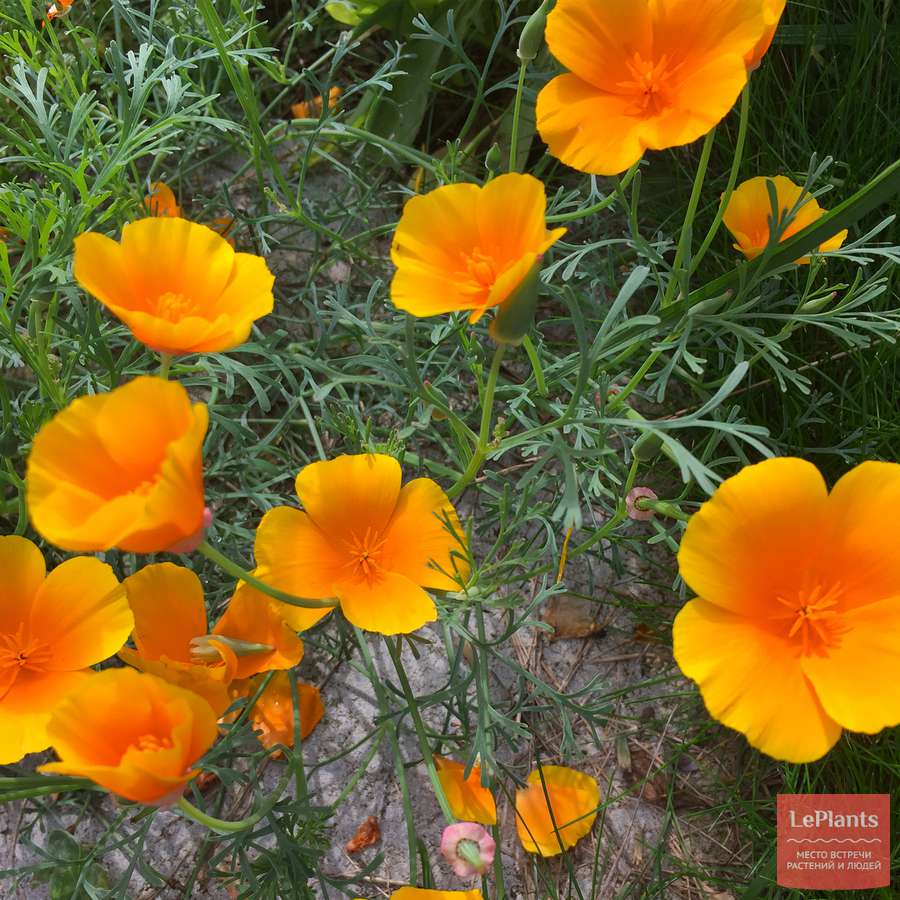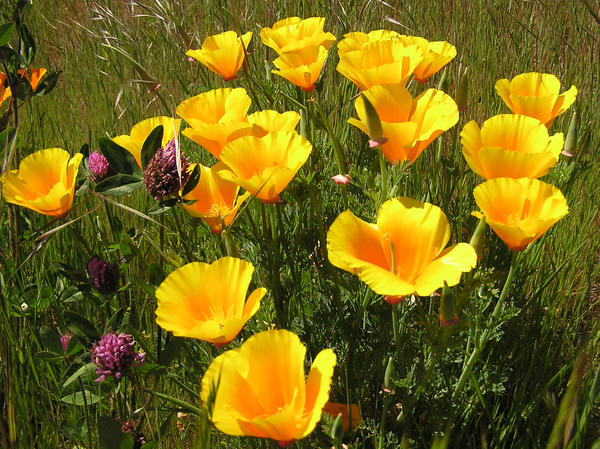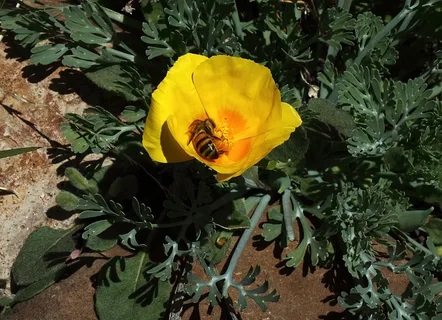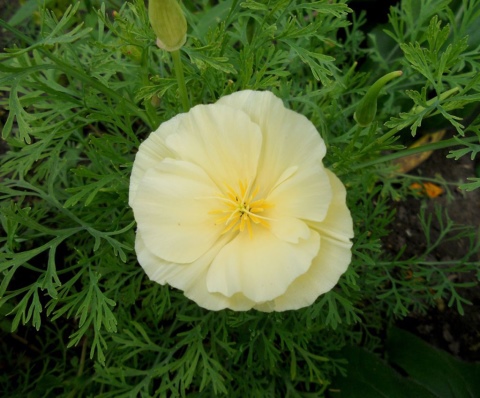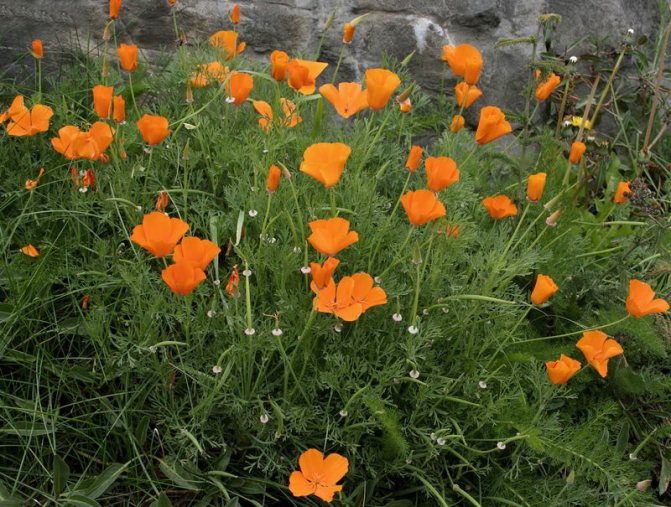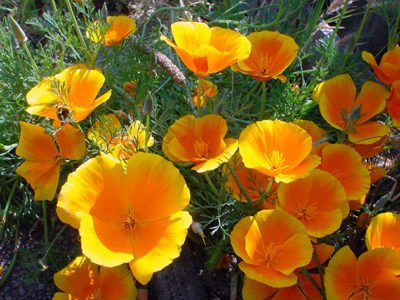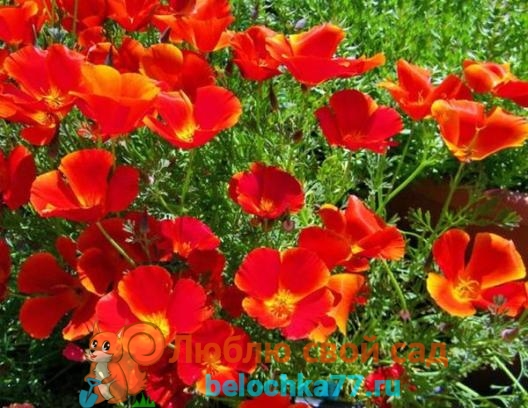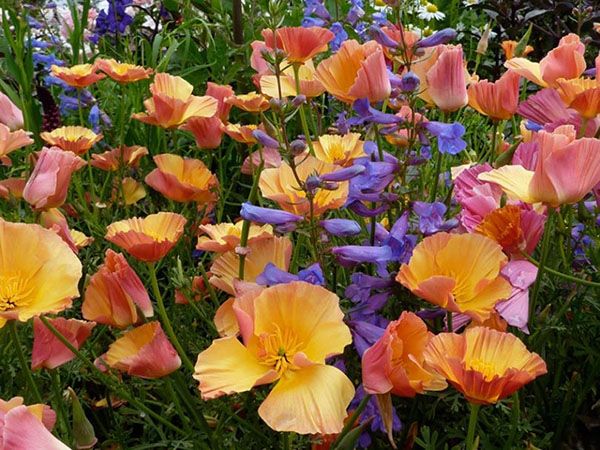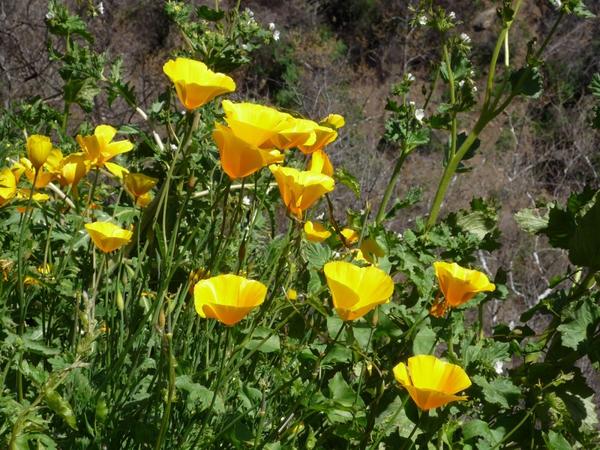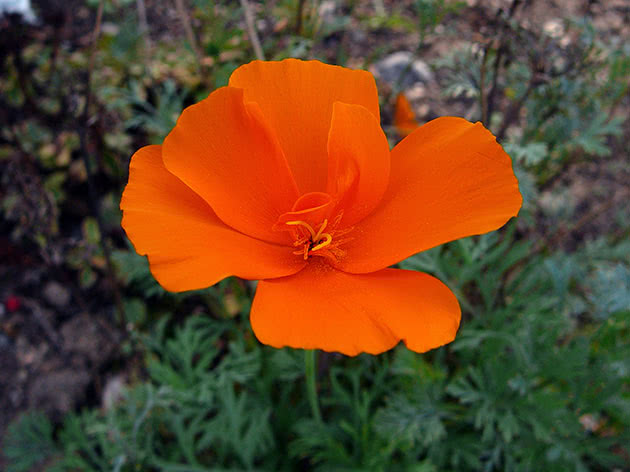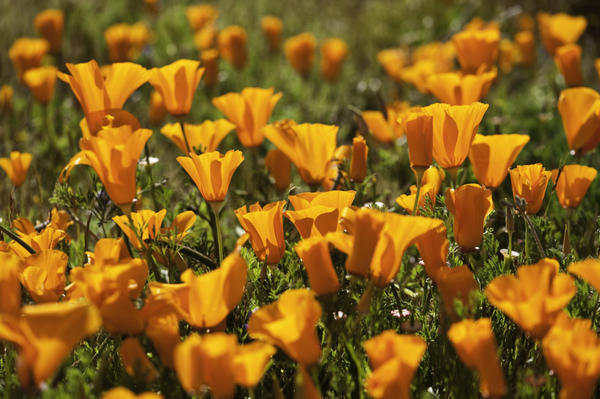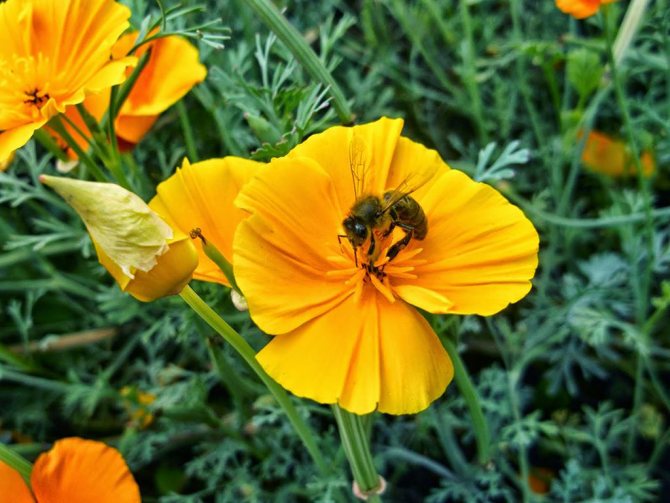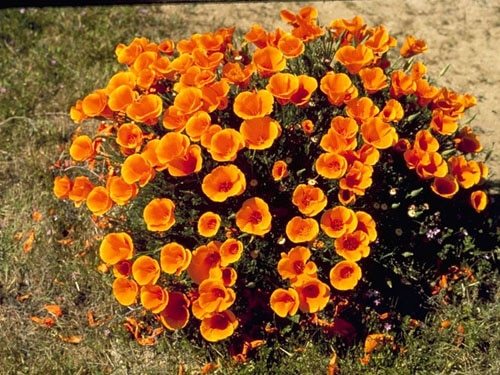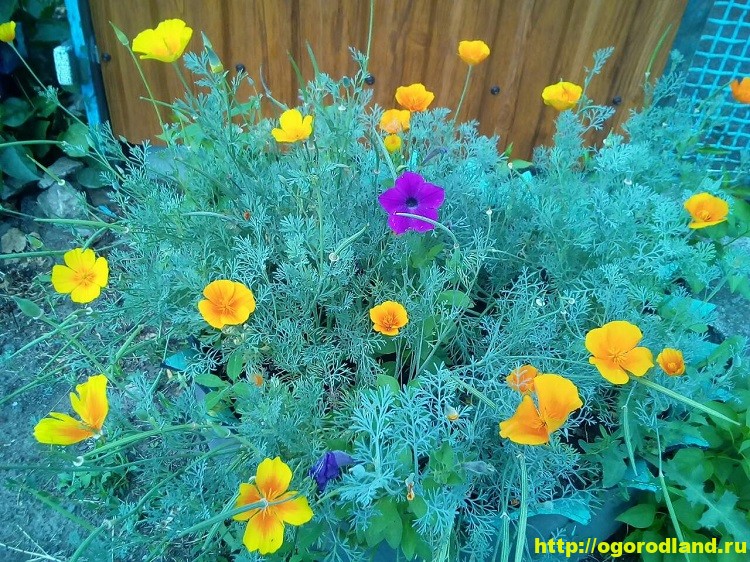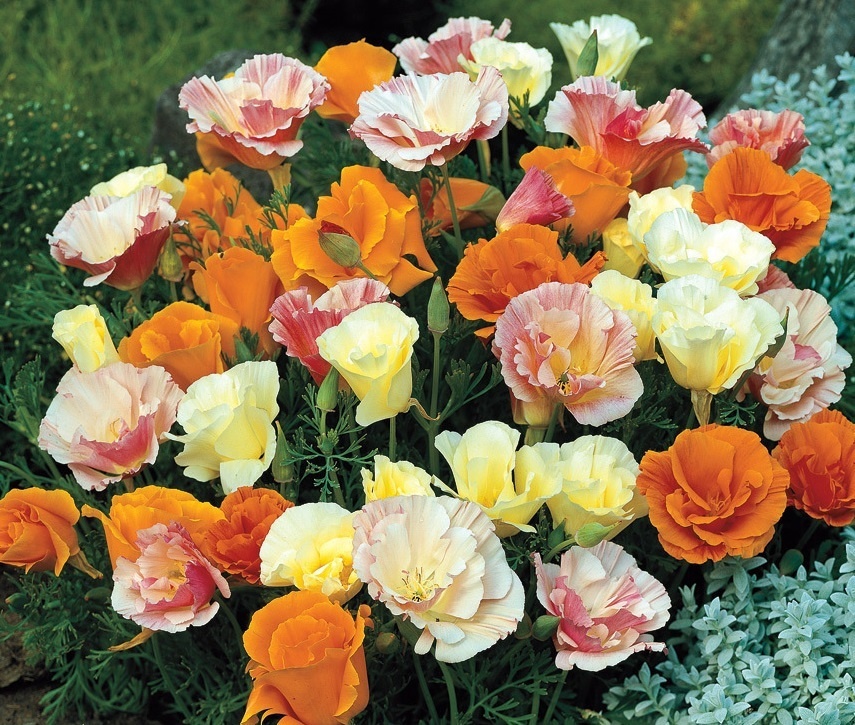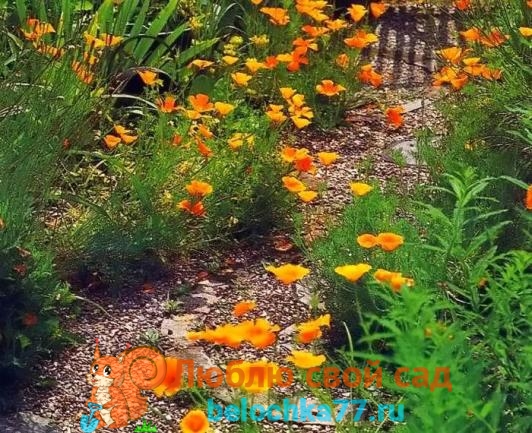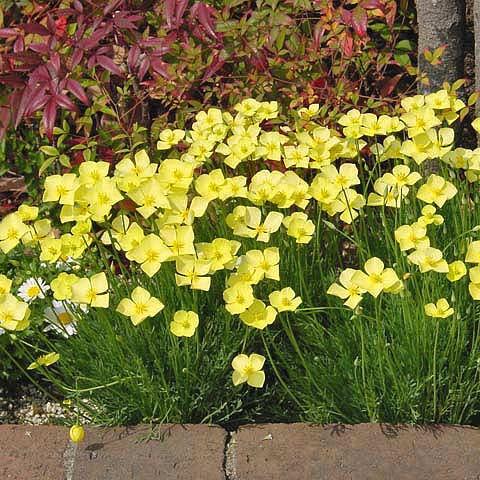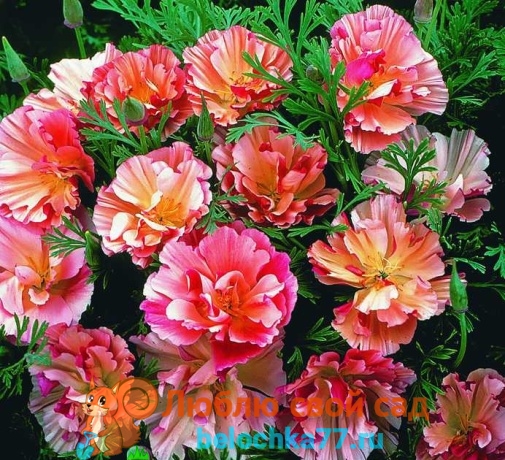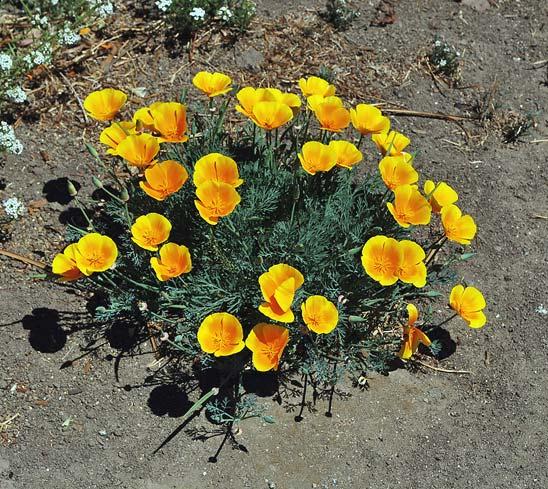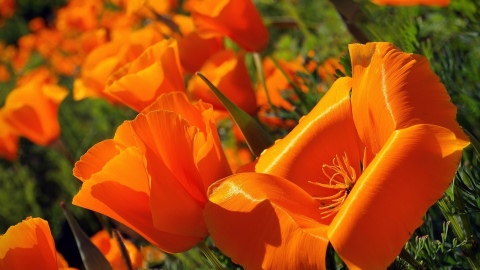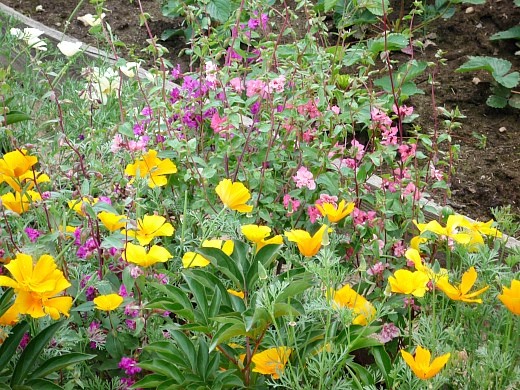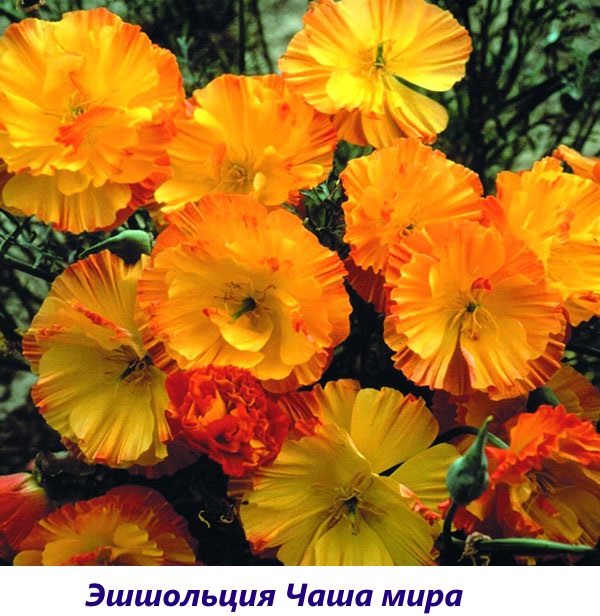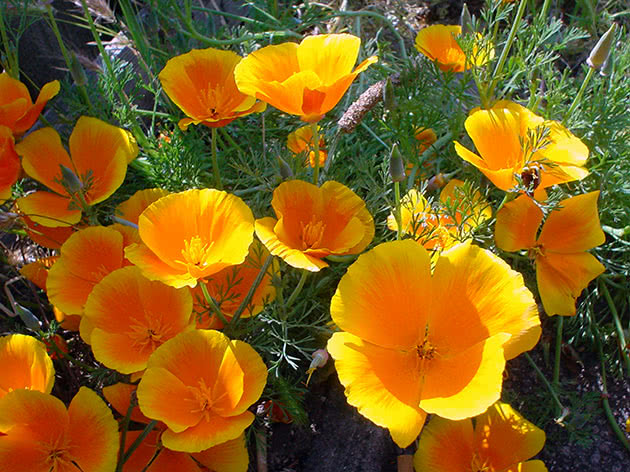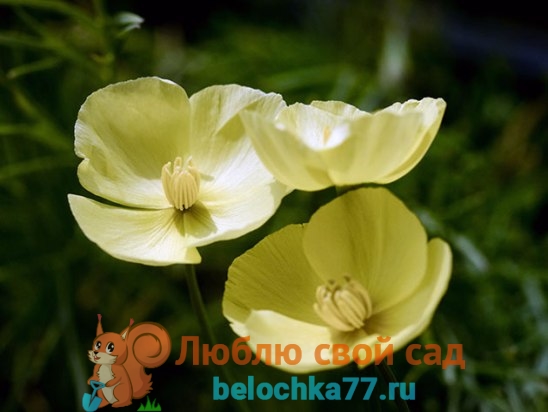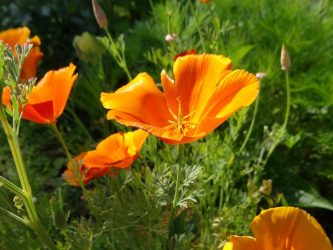Types and varieties of escholzia: description and photo at the time of flowering
Escholzia is a herbaceous plant with compact or creeping bushes. The leaves are carved, covered with a waxy coating and therefore have a bluish-green color. It has single bowl-shaped flowers 5–8 cm in diameter. It blooms in the first half of July, 40–50 days after germination, and blooms until late autumn. When describing the effoltium plant, it is worth noting that its flowers open only in sunny weather.
There are 12 types of escholzia. The most commonly grown Californian escholzia and turfy escholzia. The varieties of these species have simple, semi-double, double flowers. They open only in good sunlight (from 10 am to 4 pm). In cloudy weather, the flowers of the escholzia remain closed.

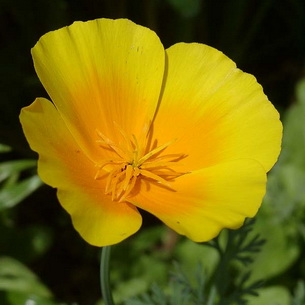
Californian eschscholzia is low or medium in height (20–45 cm). Its shoots are gray-green in color, and complexly dissected leaves form a basal rosette. The flowers of this type of escholzia are simple, corrugated, double. White, cream, yellow, orange, red and pink in color.
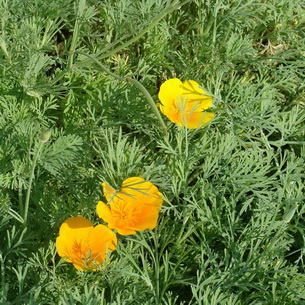
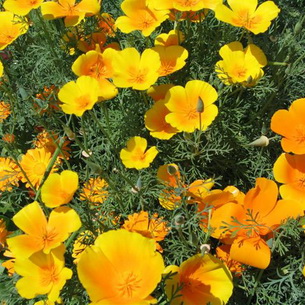
The overgrown Californian escholzia is very noticeable from a distance and seems to sparkle in the sun. There is a legend that gold ore is formed at the place where the escholzia grows in the ground. It is the fallen bright yellow petals of the plant that turn to gold.
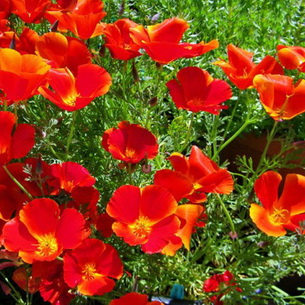
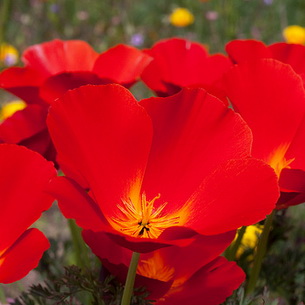
Escholzia of the Anshantre variety has double crimson-pink flowers. The Ballerina variety has semi-double and corrugated flowers, salmon-colored. The height of this plant is 25–30 cm.
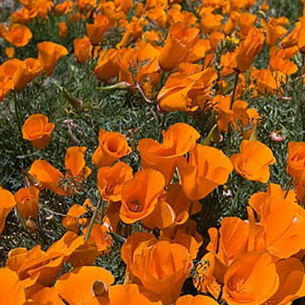
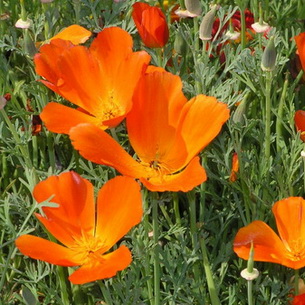
Escholzia of the Bobby variety has yellow-orange flowers and reaches a height of 40–45 cm.
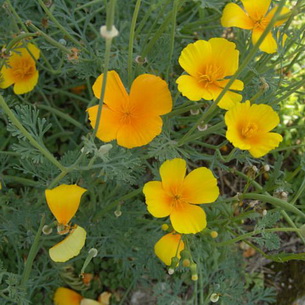
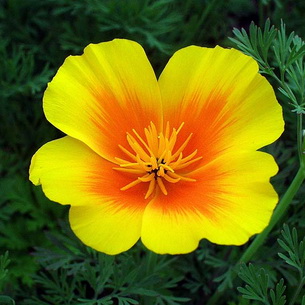
The flowers of the Golden Glory Escholzia are simple. They have even or wavy petals of an unusual color - bright yellow with orange spots.
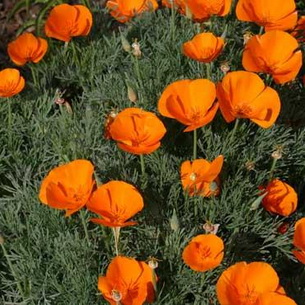
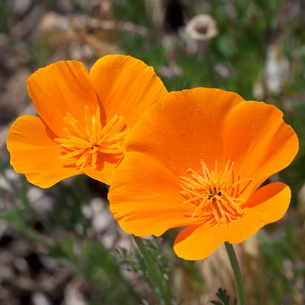
Golden Orange is distinguished by its rich orange flowers.
Pay attention to the photo of the Carmine King escholzia variety - these plants have medium-sized crimson-pink flowers that fade in the sun in the heat:

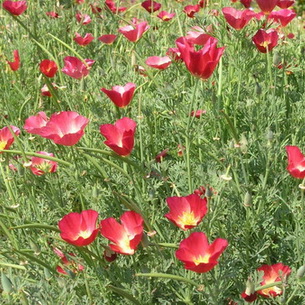
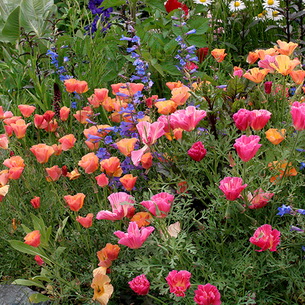
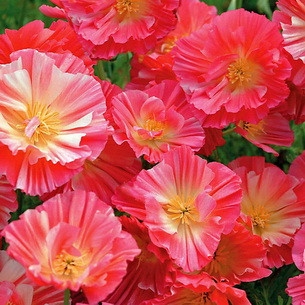
The varieties Mandarin, Orange King and Mikado have flowers of different shades of orange.

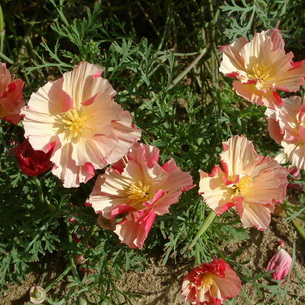
Escholzia of the Milky White variety has a creamy color of flowers.

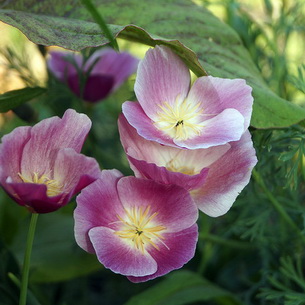
There is even an escholzia with flowers of a dark lilac color - this is the Ash Violet variety.
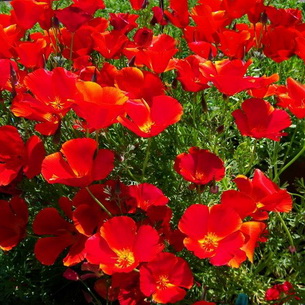
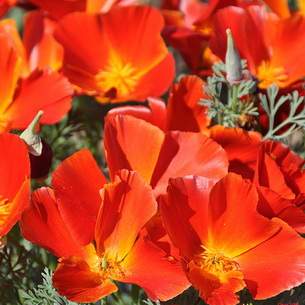
Red Chief, also a Californian variety, is distinguished by its red.
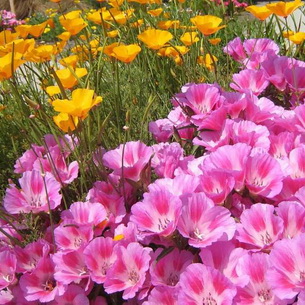
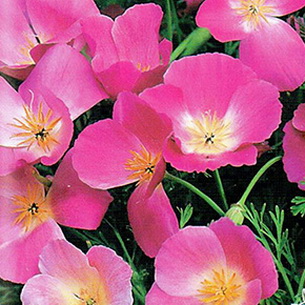
Tahiti variety - pink flowers.
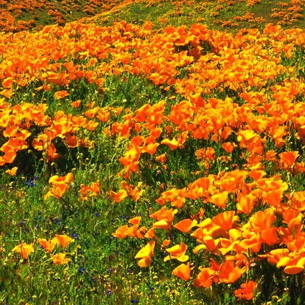

The original flowers of the Foyerflame variety are with corrugated petals of a dark orange-red color.
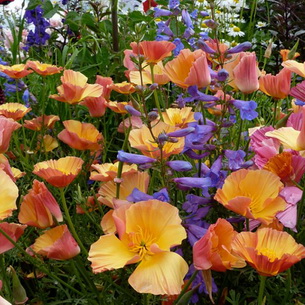
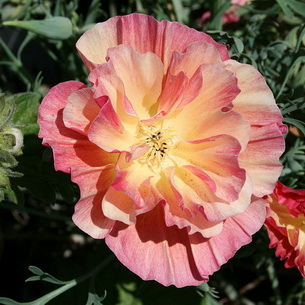
Escholzia of the Apricot Chiffon variety has aqua-colored leaves and wrinkled, cream or yellow petals. In this plant, flowers are often drooping due to heavy petals.
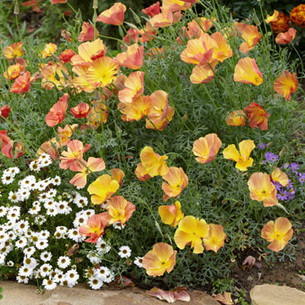
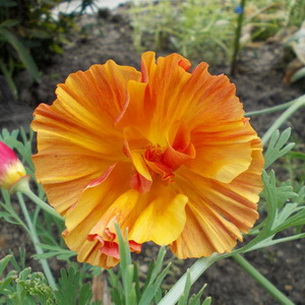
Escholzia of the Rose Chiffon variety has petals of the same color on the inside, and pink on the outside.
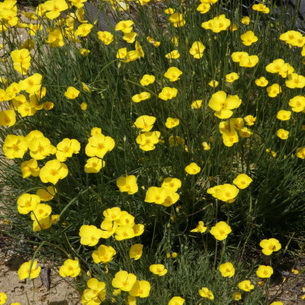

Eshsholzia turfy is distinguished by the elegance of bushes. It is only 12-15 cm high. The bushes are dense. The leaves are also complexly dissected, forming a basal rosette. The flowers are bright yellow, 3 cm in diameter.
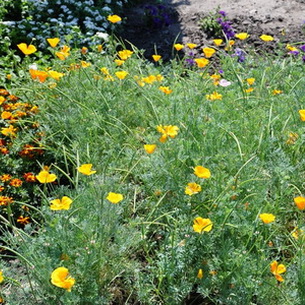
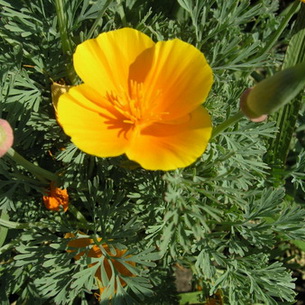
Eschsholzia Lobba forms compact bushes 13-18 cm high. This plant has flowers of different shades yellow and small diameter - 2-2.5 cm.
What the legends say
Many legends are dedicated to this delicate plant. One of them says that in the 16th century a ship with gold miners landed on the shores of North America.
Back on the coast, treasure hunters noticed a bright golden glow. This amazing mesmerizing light came from the delicate and quivering flowers of escholzia
In Spain, the plant is still called the golden bowl. However, the homeland of flowers is sunny California, where more than ten species of plants belonging to the poppy family grow.
But, despite its American origin, for the first time the flower was described by members of the Russian expedition, equipped to the New World at the beginning of the 19th century. The plant itself was named after the Russian biologist Eshsholz, who first brought flower seeds to Russia.
And they have not disappointed flower growers to this day, delighting with a bright color from the beginning of June almost until winter.And what is interesting, each flower that appears surprises for 3-4 days, and then fades, but new buds bloom instead. At the same time, the escholzia seems to be playing hide and seek with us. If it's sunny, it flaunts, demonstrating the charm of the opened buds, but as soon as it becomes cloudy or the evening comes, the plant tightly closes its petals.
Healing properties
The healing properties of the plant were already known to the Indians. So, they used escholtia to relieve toothache, head lice, and also for cosmetic purposes. Today this plant is used in many preparations in Russia, America, and European countries. For example, in France, Escholzia is grown in large quantities for raw materials.

Escholzia extract.
The buds of the plant have medicinal properties, which are harvested in the summer - dried and crushed. Eshsholzia, like other representatives of the Makovs, is rich in alkaloids, and also contains flavonoids, carotenoids. Substances from the listed groups cause the following effects from the use of the plant:
- antispasmodic action;
- sedative effect;
- hypnotic effect;
- analgesic effect.
It is important to note that preparations based on Escholtia have very little or no side effects, unlike their counterparts on a different plant basis.
So, we examined the most common types of escholtia with a photo, features of planting and care behind the plant in the open field. Eschsholzia is a very delicate, graceful and sophisticated plant, at the same time very hardy and non-capricious. It can be easily grown at home, even if you are completely new to gardening.
Video: description, planting and caring for the escholzia.
The best conditions for growing escholzia
Eschsholzia is completely unpretentious in care. She withstands temperature drop to -5 ° C, so it can delight with its flowering from early summer to autumn frosts. This flower is very light-loving and does not require abundant watering. Adult plants are quite frost-hardy, however, it is better to plant seedlings in the soil with the cessation of night frosts. After all, young plants are still very sensitive to temperature extremes and may die.
It does not matter by what method the planting takes place - seedlings or directly into the open ground, you need to remember that it is better not to arrange a transplant once again. The fact is that this flower has a weak and very delicate root that is easy to damage.
It is recommended to transplant seedlings immediately from peat tablet or with an earthen lump at a distance of at least 30 cm from each other so that future bushes have enough space and the flowers do not obscure each other's light.
If you sow seeds in the spring, it is best to do it in April. It is recommended to pre-mix them with sand and not embed them very deeply. The soil should be slightly acidic and well drained. 2 weeks after the air temperature reaches 15-18 ° C, the first shoots will appear. After another 30-40 days, the escholzia will begin to bloom.
Planting methods
However, with the second method (sowing seeds in winter), conditions are provided for the plant that are closest to natural conditions, which contributes to an earlier onset of the flowering stage.
Sowing seeds in autumn
Eschsholzia, which was planted in the fall, is capable of blooming at the very beginning of May, if all the requirements are met, which involve not only proper seed preparation, but also care. It is necessary to carry out planting work with this method of cultivation in October.
The seeds of the California poppy are quite small, so when planting they should be slightly pressed into the ground. After that, the planting should be necessarily mulched so that the surface of the soil does not harden and makes it possible for seedlings to appear. The advantage of this method is that the seeds undergo natural stratification and give the best germination results.
Spring sowing of seeds
If sowing seeds to a permanent place is planned for the springtime, then it is advisable to store the planting material in the refrigerator throughout the winter, on the lower shelf. Thus, the seeds are prepared for planting. To sow more or less evenly, the seeds can be mixed with sand.
Eschsholzia will delight the grower with the first shoots in 1.5-2 weeks. The first procedures, which include caring for plants, can be carried out after some time: when the sprouts are about 12-15 cm high, they should be thinned out, leaving the strongest at a distance of 20 cm from each other.
Growing seedlings
This method of planting escholzia is practiced quite rarely and only by experienced gardeners. The procedure for growing plants through seedlings is complicated by those who have a rod-shaped and long root system in this culture, and can be damaged during transplantation. And more careful care of the seedlings is required.
Growing escholzia in this way can be carried out at home in a mini-greenhouse or using peat tablets (see photo). The first shoots are shown, as a rule, from 10 to 15 day after landing... With the appearance of sprouts, they are placed in a bright place where the temperature does not rise above +20 degrees. Hardening can be started 2 weeks before the planned transplantation into open ground.
Diseases and pests
As you can see, it is not at all difficult to grow and care for escholzia, but only if the gardener clearly fulfills all the requirements for planting seeds, planting seedlings and subsequent care for it. If all these rules are not followed, then there is a great risk of facing difficulties associated with the occurrence of various diseases.
At the beginning of summer, Echscholzia is often attacked by a bean aphid, which can be destroyed by using the Komandor preparation for spraying. If it is a sultry summer outside, then there is a possibility that spider mites will start on the plant, which can be overcome with the insecticidal preparation Actellik. Remember that watering should be moderate, otherwise, there is a possibility of rotting of the root system and other parts of the plant. If this happens, then watering should be immediately reduced, and all damaged areas of the flower should be removed in order to prevent the spread of rot throughout the bush. If the lesion was not noticed immediately and spread to the entire plant, then the specimen will simply have to be removed from the garden.
Also, Escholzia can be defeated by powdery mildew. In this case, the shrubs must be treated with sulfur.
Eschsholzia cultivation from seed to seedlings and in open ground
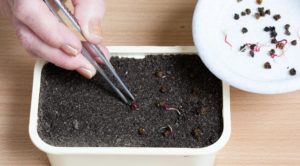
Escholzia is a shrub herb native to North America. In wildlife it is a perennial. Amateur gardeners grow it as an annual crop.
The abundant flowering of Escholzia is observed for several months, although one flower bud blooms for only 4 days.
Escholzia petals, depending on the variety, can have shades of warm white, pink, burgundy and even purple. Escholzia terry is especially good.
How to grow escholzia
When grown from seeds, 2 methods are used:
- sowing seeds directly into the ground in the garden;
- growing seedlings at home.
Growing seedlings is extremely rare. This applies primarily to northern regions with short summers and unstable weather, or when there is a desire to observe flowering much earlier than the established dates.
Basically, the first method is used, when the seeds are sown directly into the ground. Moreover, the soil does not need preparation, since escholzia can grow on any soil.
It is widely used for landscape gardening, in flower beds and ridges
Ground sowing terms
Soil sowing can be carried out both in autumn in October and in spring in April.
During autumn sowing, purchased or harvested seeds are not stratified.They are sown in the month of October on a prepared plot just before the first snow falls.
Cover this place with a large amount of fallen leaves, creating a layer of natural insulation. Such conditions will help them to pass their natural hardening. The first shoots will appear in early spring.
They will be stronger and more resilient than spring seedlings. And, of course, the color will pick up at an earlier date.
If you leave Escholzia seeds for planting in the spring, then you need to put them in the refrigerator for the whole winter for the stratification process. For this, the seeds are placed in a paper bag and placed on the lower shelf of the machine.
Before planting in the month of April, an open, sunny place is chosen and dug up. Adding sandstone to the soil will bring it closer to the natural one on which the ancestors of this culture grew. Seeds are placed in grooves with a depth of 2-3 cm, slightly deepening.
Sand mixed with peat is used as the top layer.
Growing with seedlings
Sowing seeds to obtain seedlings of Escholzia is recommended to be carried out closer to mid-March. The stratified seeds are soaked in a growth stimulant solution using the instructions.
Sowing is carried out on a swollen peat tablet, at the rate of 2 pieces of flower seed per 1 tablet, so that later during transplantation it does not damage the core root of the young escholzia. Sprinkle the seeds with peat.
Seedlings are grown in containers, where peat tablets are placed. Cover with foil from above and ventilate daily. Optimal conditions for seed germination: temperature within + 20 ° C and maximum lighting.
After a couple of months, and this is mid-May, the seedlings are transferred to open ground directly with a tablet. And somewhere in a month, Escholzia will begin to bloom until the first autumn frosts.
Unpretentious plant to care for
Escholzia does not need abundant watering. You can even forget about watering, the plant will easily endure it. In addition to spring feeding during the entire growing season, she does not need anything. It only needs to loosen the soil and remove wilted lashes and inflorescences in order to conquer with its impeccable appearance.
Eschsholzia, California poppy
How to collect seeds
If you liked the Escholzia variety, then after flowering, as soon as a box is formed, you need to hang a gauze bag on it. In this position, the seeds will ripen and will not spill out onto the ground. The collected seeds are dried and harvested for stratification, thereby preparing them for the next season.
Gardener's advice
If you want to observe escholzia of different colors and shades on your site, then you need to sow it in the ground every year. Self-seeding, if it survives the winter cold, will give only natural yellow flowers.
How to grow escholzia from seeds
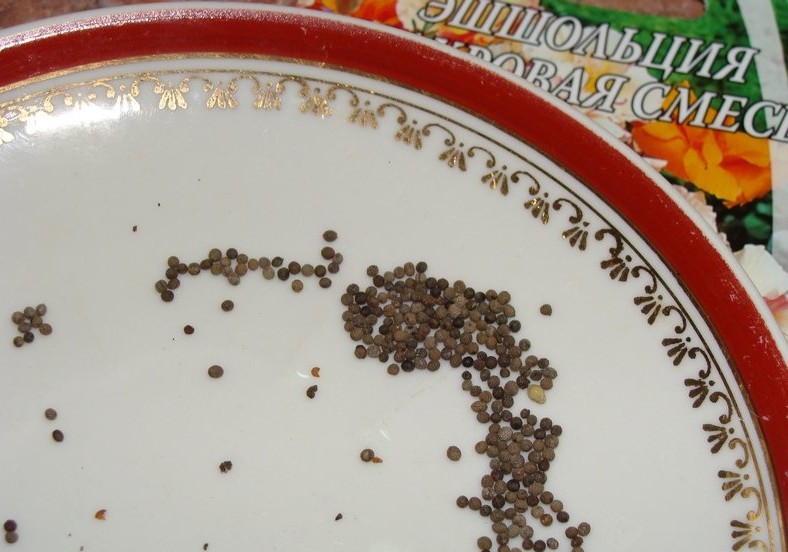
Photo of seeds
Due to its non-capriciousness and patience with growing conditions, escholzia can be sown with seeds directly into the ground. Moreover, it can be sown not only in spring, but also before winter. If the seeds are sown in October, under the first snow, during the winter they undergo natural stratification, and in the spring, as early as possible, strong viable shoots appear, which will begin to bloom much earlier than those sown in spring.
Traditional spring sowing can be done as early as April. Prior to this, in the fall, the harvested and dried seeds should be placed in the refrigerator. They will be stored there until April, at the same time stratifying.
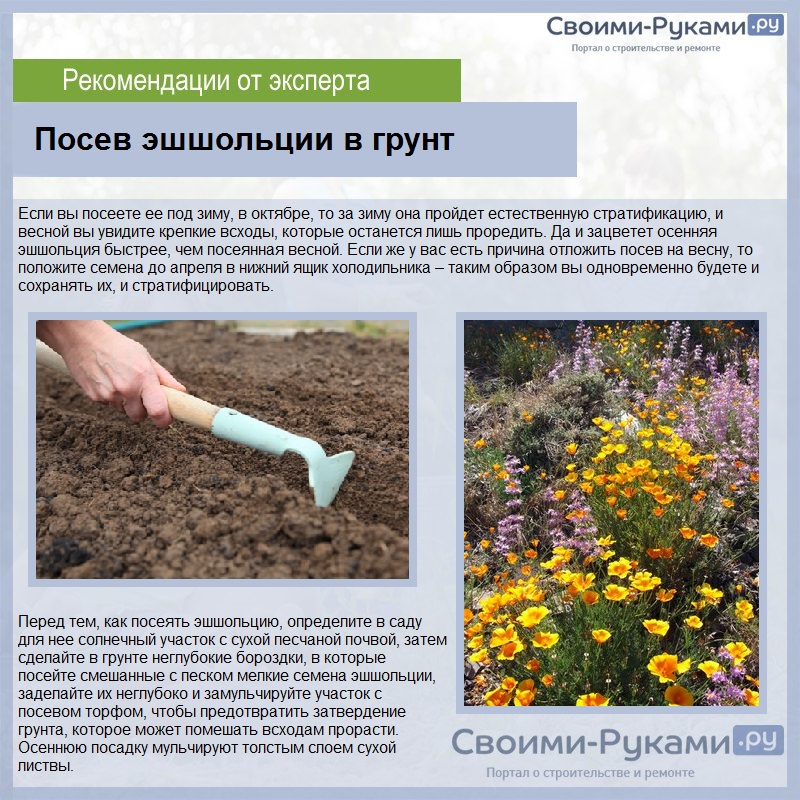
Sowing escholzia in the ground
How to sow escholzia in unprotected soil
The soil in the flowerbed before the sowing procedure, it does not matter whether it is spring or autumn, must be well prepared. You don't want the sprouts to die! Preparation will not take much time and effort
- Take the site bright, sunny.
- The soil is preferable sandy, not packed, crumbly, breathable, moisture absorbing.
- The reaction of the soil is weak in acidity. For normalization, add dolomite flour or ash.
-
The soil is carefully dug up to twenty centimeters deep.
- Fertilizer for sowing is not necessary. Enough pre-sowing preparation and seed treatment.
- If sowing occurs in the fall, foliage or other mulching material will be needed.
-
In the dug and loosened soil, grooves are made.
-
Seeds are sown to a depth of two centimeters, mixed with sand of the same fraction as the seeds.
- The grooves are covered with peat, watered (in spring, in autumn, sowing is carried out dry).
-
When sowing in autumn, the flowerbed is mulched with fallen leaves, large sawdust, needles or bark.
Growing seedlings of escholzia
To ensure the production of seedlings or to design decorative ornaments that involve planting ready-made seedlings according to a given color and growth scheme, escholzia is often grown as seedlings.
Preliminary preparation, as with sowing in the ground, is stratification in the cold.

How to stratify seeds
Then, in the month of March, in the middle, you can sow escholtia for seedlings.
Sowing seeds
The seeds must be prepared first. Soak in a solution of potassium permanganate or dust with fungicides. For better germination, seeds can be treated with growth stimulants.
-
Peat pots are placed in a large container with water poured into it. It is necessary to wait until the peat absorbs water and swells.
-
Then remove from the water and place with tweezers, or as convenient, transfer two seeds to each tablet.
-
Seeds are sprinkled with sown peat, 1 mm layer. The soil is sprayed with water.
-
The tablets are placed in a dry container, covered with a film cover or glass is placed on top.
- Crops are set to light and at a temperature not exceeding + 20 ° C.
- Care in the process of germination - wetting the surface, airing.
Emergence of seedlings
The sprouts will emerge from the soil within two weeks. The cover made of film or glass can be removed. The location changes to a lighter, maximum illuminated one. The temperature of the content remains the same. Two weeks later, you can make the debut feeding with a liquid complex of minerals, the proportions are twice weaker than those indicated in the instructions.
It is better to plant seedlings in the ground in May. Eschsholzia is not afraid of return frosts if it has grown from seeds in a flower bed. Home seedlings must be hardened before planting. After hardening, it can withstand a drop in night temperatures down to -5 ° C on the soil.
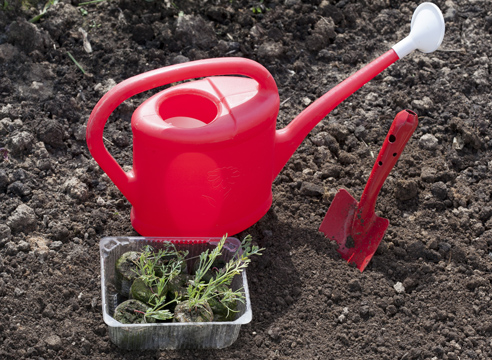
Planting sprouts in the ground
Landing on a flower bed
For planting, the flower bed must also be prepared. The earth must be dug up in advance, at least three weeks in advance. Before planting, holes are made in it, the distance between which is recommended to be kept up to 30 cm, so that each plant has enough nutritional area.
Together with the peat tablet, the seedling is carefully moved into the hole to the desired depth. Planting is sprinkled with soil, watered.
Carefully place the seedlings in small holes so as not to damage the sprouted roots.
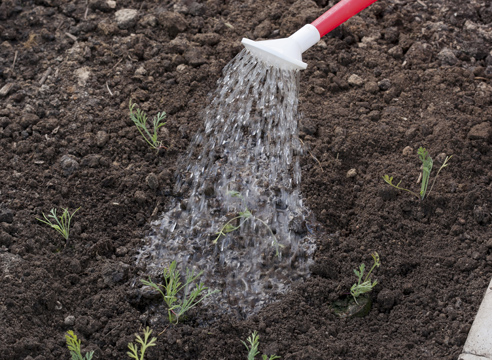
Water the planted seedlings
Escholzia begins to bloom on the thirty-fifth day after sowing the seeds. And, with proper care, it continues to bloom until the onset of frost.
The healing properties of escholzia
Until now, Escholzia extract is used in traditional medicine and is part of some medicines. The analgesic and sedative effect of the flower, against the background of complete safety, allows it to be used even in pediatrics as a sedative with mild properties. The Indians living in America were well aware of the beneficial qualities of aescholce and actively used it against various diseases. To relieve a toothache, they used all the ground parts, a decoction of the petals helped to get rid of lice. The pollen collected by the women helped them maintain the freshness and elasticity of their skin.
Planting escholzia with seeds and growing in the open field
Soil and planting site conditions
This plant can be planted in the country even by those who are completely far from floriculture.Caring for an escholzia is so simple that any inexperienced person can master it. These flowers are planted only in sunny areas, since they do not tolerate the slightest partial shade. In places with any shading, it blooms poorly and grows poorly.
It is noteworthy that escholzia can develop well even on infertile and dry land (this is how it was rejuvenated - a stone rose - is different), therefore we place it in those places of the summer cottage where not a single flowering plant can grow. It develops excellently on dry sandy soils, poor in humus, but does not tolerate acidic soils. You should also be careful with watering, since excess moisture is detrimental to her. It should be remembered that you should not abuse any fertilizers (organic, mineral). It is better not to fertilize at all those areas where escholzia grows. Also, these flowers should not be transplanted as they have a fragile taproot that breaks easily.

Sowing seeds into the soil
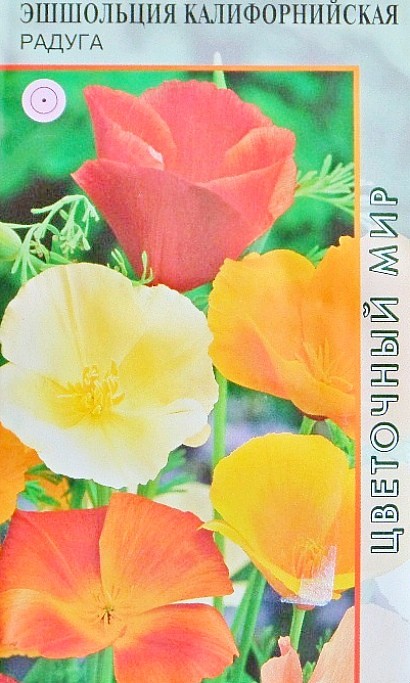
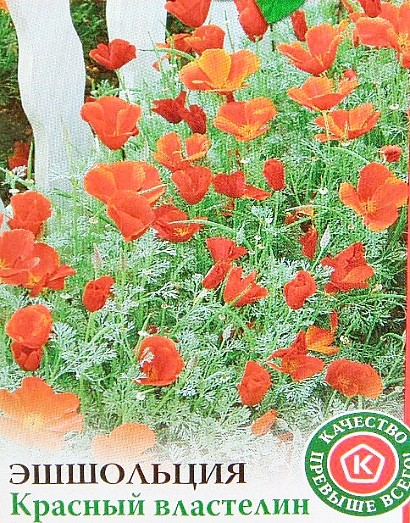
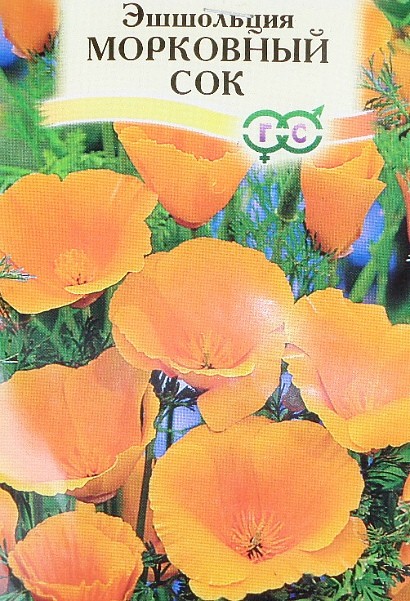

We grow this plant only with seeds. Planting them does not require any special preliminary actions, except for preparing a place for sowing seeds. It is carried out in April or October. Escholzia seeds are very frost-resistant. They can easily endure even very cold winters. We loosen the soil before sowing. We sow the seeds in rows. The interval between them should be about 20 cm. Then we press them a little into the soil and mulch with fallen leaves. Mulching is necessary so that after rains the soil surface does not harden too much, as this reduces the germination of Escholzia seeds. When sowing in autumn, we get an early and lush flowering. Water the spring crops well. The first shoots of flowers are shown in 2 weeks. Their seeds remain viable for up to 3 years. Helps in reproduction and self-seeding.
We sow Escholzia right at the summer cottage because its tap roots are quite long and fragile, so any transplant can simply destroy young plants. We thin out the seedlings, leaving the strongest specimens. The distance between flowers is 20 cm, since with a large thickening it is difficult to get lush and branched specimens. We carefully weed the crops, trying not to damage the seedlings.
As an option for direct seeding into the ground, we can place the seeds under a greenhouse glass in peat pots. After the seedlings grow up and get stronger, we plant them right with the pots in the ground in a permanent place.
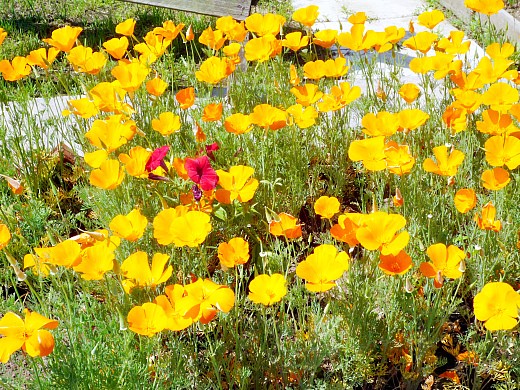
Summer care for eschscholzia
The adult plant is semi-creeping, so weeding the escholzia is very difficult. We remove weeds only by hand, since all its parts are quite fragile and can easily break from mechanical action with a hoe. Before the beginning of budding, we carry out top dressing, for which we breed 1 tsp. nitrophosphate, 1 tsp. flower fertilizer, 1 tsp. vermicompost in 10 liters of water. For 1 sq. m. land will need 5 liters. We don’t do any more fertilizing.
Caring for the escholzia consists, among other things, in periodic watering, which are made when the soil dries out. In dry periods, soil moistening is carried out more often. At the same time, watering is carried out only in the evening, when the buds have already closed. And we do this procedure not every day. It is necessary to water only if the soil dries out, since excess moisture often leads to a slowdown in plant growth and its death.
Collecting plant seeds after flowering
We collect planting material only from yellowed fruits, since unripe seeds practically do not germinate. A month after the buds have faded, pods grow in their place, which contain small seeds. Timely removal of wilted flowers and fruit pods stimulates the extension of the flowering period of the escholzia.If ripe fruits are not removed in time, the seeds will spread throughout the nearby area so much that next year this plant will multiply throughout the summer cottage like a weed (here the purslane also has such a sin).
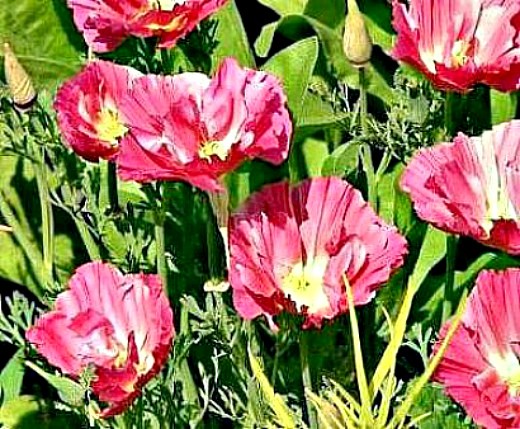
Diseases and pests of escholtia
With excessive soil moisture, rotting of different parts of the flowers can be observed. We immediately remove such specimens, and significantly reduce watering. In case of defeat by various viral infections that provoke crushing and yellowing of plants, we immediately remove them.
Escholzia is often affected by the bean aphid. With prolonged drought, the plant can be attacked by a spider mite. To combat these insects, we use various insecticides ("Actellik", "Commander").
Common types and varieties of the Escholzia flower
The escholzium genus consists of only 12 species. However, most of them have many cultivars, different forms and varieties.
Californian escholzia, aka Californian poppy.
Typical variety, most common among garden plant lovers. This escholzia is the emblem and symbol of California. Herbaceous plant with partially creeping shoots. The height of the shrub does not exceed 43-46 cm.
The species is distinguished by a large number of varieties with various flower colors.
- Mikado. The inflorescences are simple, of 4 petals, painted in a rich bright red hue, the middle is slightly darker.
- Apple tree flowers. Large simple or double inflorescences are pale pink in color. This variety easily tolerates small frosts.
- Strawberry fields. The bright yellow core smoothly turns into red at the edges of the petals. Inflorescences are semi-double, the number of petals is 6-9.
- Golden glory. The inflorescences are simple, painted in a very bright yellow tint, turning orange in the middle.
- Peach ice cream (Pearh sorbet). Lush terry inflorescences have a delicate pinkish-cream color.
- Karminkoenig. Simple large-sized inflorescences are painted in a rich garnet shade with a white center.
- Orange king. Inflorescences can be simple, semi-double and double. The color is bright, orange-golden.
- Apricot chiffon (Apricot shiffon). An original, recently bred variety. The leaves and shoots are colored blue-green, and the inflorescences are a mixture of orange, gold and pink. The petals are corrugated and slightly wrinkled, collected in double flowers.
- Fruit crash. Varietal mixture of semi-double inflorescences with corrugated petals. The color can be red, pink, yellow, burgundy and crimson.
Eshsholzia turfy
Herbaceous miniature bushes, reaching a height of only 1-1.5 dm. The leaves are dissected, covered with a whitish bloom. The inflorescences are simple, consist of 4 petals, the color is always yellow.
Eschsolzia Lobby
A low plant (up to 17 cm tall), most often used to decorate alpine slides. Inflorescences are small, their diameter does not exceed 3 cm, the color is pale yellow or yellow.
Post-flowering period
Seed collection
Seed should be harvested after flowering. Before collecting the seeds, you need to construct gauze pouches. Then they are put on a withered flower and the seeds are waiting for the ripening. Usually, the planting material is ready within a month after flowering, it is dumped into the bag itself.
Next, the gardener must cut off the bag, shake out the seeds on a sheet of paper, dry them, place them in a paper bag or cotton bag and store them on the bottom shelf of the refrigerator. If all the collection rules were followed, then such seeds will remain viable for three years.
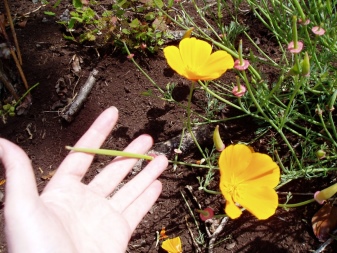
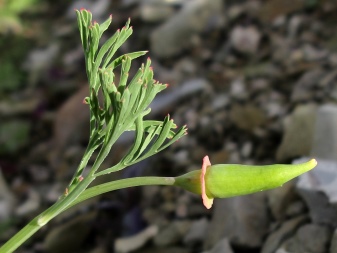
Wintering
It is a perennial crop, but in temperate latitudes it is usually kept as an annual. The fact is that the plant is very vulnerable to cold weather and, as a rule, cannot survive the cold. Therefore, before wintering, gardeners dispose of the frozen tops and prepare a site for future plantings.
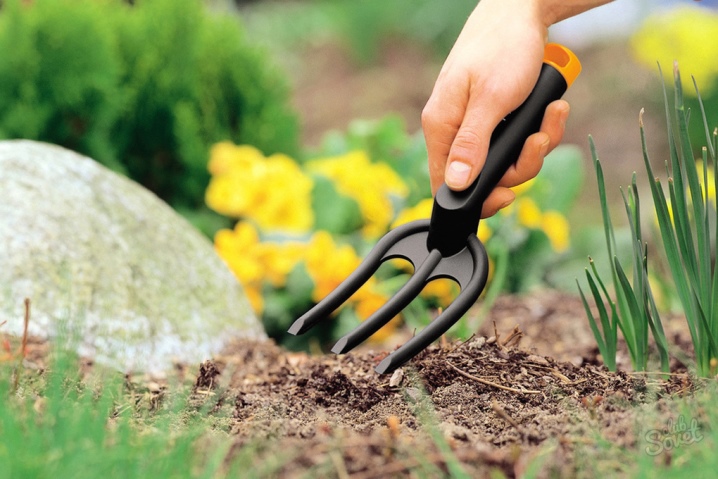
SEEDING ESCHOLZIA
In order for California poppies to bloom in the garden in the early days of summer, pre-winter sowing is usually carried out or the seedling method is used. How it's done?
The plant propagates by sowing small seeds that germinate easily in the soil, and during storage they remain viable for 2 years. If you intend to sow escholzia immediately to a specific place, you need to choose an illuminated area where water will not stagnate. It is desirable that the soil is neutral or slightly acidic.
Since the seeds of Escholzia are very small, they are mixed with dry sand before sowing. Then it is sown on slightly compacted soil, after which it is watered. The first tender sprouts break through after 1.5-2 weeks. When true leaves form in young Echscholzia, the plants can be thinned out, leaving one for every 20-25 cm.
To speed up the start of flowering, plants are sown for seedlings from the second half of March to early April. If this is not done in time, the plant will quickly form a long and fragile taproot that can be easily damaged during transfer to the front garden. And one more thing: when preparing the soil for escholzia, it is worth considering that this plant may suffer due to the introduction of fresh organic matter into the soil, as well as excessive watering.
Escholzia | sowing seeds for seedlings | Part 1

